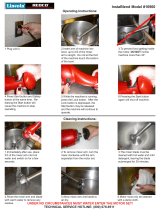
17
Disposal of the appliance
Please note that this Andrew James product is mark with this
Symbol:
This means that this product must not be disposed of together
with ordinary household waste, as electrical and electronic waste
must be disposed of separately.
In accordance with the WEEE direcve, every member state must ensure
correct collecon, recovery, handling and recycling of electrical and
electronic waste. Private households in the E.U. can take used equipment
to special recycling staons free of charge. In certain member states used
apparatus can be returned to the dealer where they were bought on the
condion you buy new products. Contact your retailer, distributor or the
municipal authories for further informaon on what you should do with
electrical and electronic waste.
UK and EU Guarantee
Your new Andrew James product comes with a 24 month guarantee and a
2 year xed warranty, eecve from receipt conrmaon. Your receipt or
order number is required as proof of purchase date so it is imperave that
you keep it safe. This guarantee only applies if the item has been used
solely for the use intended, and all instrucons have been followed
accordingly. Please note this product is for domesc use only and is not for
commercial use.
Abuse of your product will invalidate the guarantee. Returned goods can
only be accepted if repackaged properly within the original colour product
box, and presented with the original receipt of sale/order number. This
does not aect your statutory rights.
Returned products must be cleaned and returned to us in as close to
delivery condion as possible.
If your product develops a problem within the rst 12 months of the xed
warranty, we will pay all shipping costs to have it returned to us. Aer 12
months the customer will be liable for the cost of returning the product to
us. We will then pay to have the repaired/replaced item shipped back to
the customer.





















